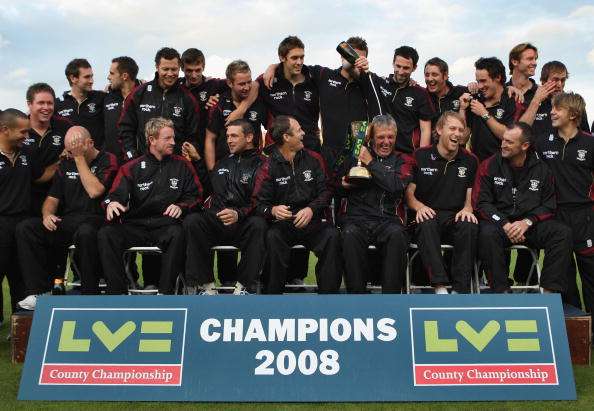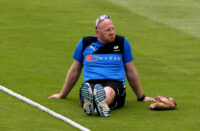Derek Pringle suggests that the county’s request to be bailed out is symptomatic of deeper problems that face the game as a whole
Ambition is generally a good thing in both life and sport, but overreach and it can get you into trouble as Durham CCC have discovered.
Not on the field you understand, where they have won three County Championships in the last seven years, but off it in the boardroom where lofty aspirations have run into commercial difficulties of such gravity that they have asked the ECB to help bail them out.
It is a cautionary tale and one the ECB have set up a working party under Ian Lovett, the vice-chairman, to tackle. Given the ECB already subsidise each first-class county to the tune of £1.8m a year they do not want, in the words of one ECB insider, “to set a precedent where the floodgates open and they become the lender of last resort to every county that is badly run”.
But is Durham a basket case or have they been victims of a cocktail of circumstance whereby recession, unrealistic goals and social geography have combined to bring them to where they are, deeply in debt?
Most speak highly of David Harker, Durham’s chief executive, while club chairman Clive Leach was the county’s first professional cricketer in the Sixties and subsequently a successful businessman. They also have a mysterious shareholder from Hong Kong, whose influence upon the club’s strategy is not known. What is known, is that sport is mostly a business of unreliable returns which can dash the financial expectations of those eager to leave a legacy.
Durham, who gained first-class status in 1991, will claim that the development of their current ground, the Riverside (currently branded Emirates Riverside), came with a directive from the ECB to make it a top-class facility capable of staging international cricket.
The extra cost incurred and the subsequent bidding process needed to acquire the Tests and ODIs to justify it (they borrowed £2m off the local council to secure the 2013 Ashes Test), has seen losses accrue to the point where they have run a £500,000 deficit for the past six years.
For a business with a turnover of about £5m that is a parlous state to be in, though nearly all counties who have been expansionist, in ambition as well as ground improvements (like Hampshire, Warwickshire, Glamorgan and Yorkshire), have run into similar difficulties.
It is easy to have some sympathy for such clubs, especially when the attractiveness of international opponents can have such a variable effect on revenue. The difference between staging a Test against Australia as opposed to Pakistan can be as much as £1m, the amount Warwickshire need to make every season just to service their debt.
Despite this discrimination there will be those, many within the ECB, who feel that counties must live more within their means. Citing Durham’s 2012 breach of the £1.8m salary cap, a playing bill they could ill-afford and which saw them fined, they feel the club has, on occasion, been reckless in their spending.
Harker counters this by claiming that Durham had several England players, who had been on central contracts with the ECB, return to the club that season, thereby unexpectedly adding to the wage bill. He also points out that such profligacy has not gone unchecked and in 2014 Durham’s wage bill, net of national insurance and pensions, was £856,500, which made them the lowest in the First Division and 13th of 18 overall.
Such measures, while welcome, will only impress creditors so far and if a rescue package is forthcoming from the ECB it will stipulate that Durham will not be able to spend any of the money on overseas or Kolpak players.
Mind you, Durham could sign AB de Villiers and still not see a spike in local interest. Located in Chester-le-Street, mid-way between the football-obsessed conurbations of Newcastle and Sunderland, it is not classic cricket hinterland.
As a result the club and game generally are not well-supported, at least not by feet through the gate. Indeed, what support there is cannot be charged premium ticket prices for international matches, as other clubs do, because the local economy cannot sustain them.
The recent Ashes Test was an exception, but that has a Britain-wide pull especially to cricket fans in Scotland, for whom Durham is the nearest Test ground. Receipts from that match, a fine spectacle which England won, managed to stabilise the club’s financial position for a while but was unable to reduce their debts.
Unsurprisingly, ECB are keen to keep the detail of any rescue package under wraps. They have helped counties before, by loaning money and easing cash flow problems with early payments. About 15 years ago they lent Glamorgan £200,000 to help with debts. But such remedies are sticking plasters and Glamorgan have not since become a paragon of financial success.
Under Tom Harrison, ECB’s recent chief executive, and with the appointment of a new finance director at ECB imminent, Durham are hoping for a significant solution to haul them from a mire of debt they believe is not entirely of their own making.
While we await the ECB’s solution, most counties could do with extra funds. One obvious way would be more domestic cricket on TV, with the funds generated ring-fenced for county clubs. The problem is that the only value to be exploited by broadcasters is through televising a franchise-based T20 competition, something that would exclude many counties in their current form.
One solution, and it has been discussed at ECB, would be to pay the counties outside the main cities (any franchises are likely to be city-based) a fee of around £300-400,000 not to oppose the scheme but also not to be part of it, money, seemingly, being the solution to all problems in the 21st century.
That way cricket and its supporters might be the poorer but everyone else will be richer, Durham included. Ambitious, undoubtedly. A lasting solution to county cricket’s ills, unlikely.
This piece originally featured in The Cricket Paper, Friday April 29 2016












